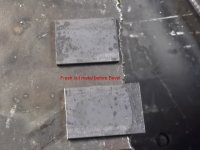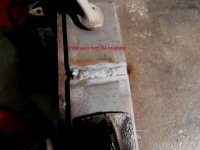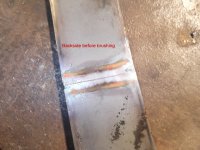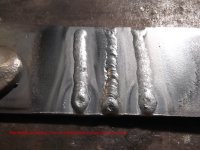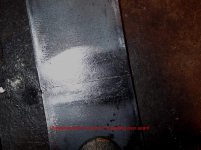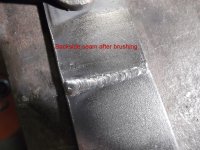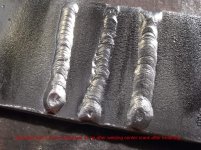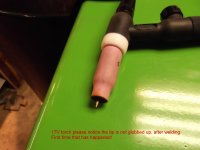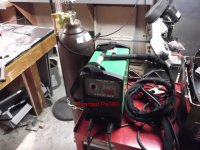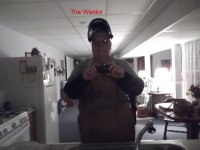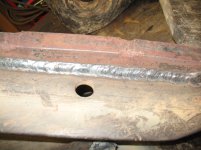Tollster
Veteran Member
As a current welding inspector in the power generation industry,I honestly could never tell you how to do your job and quite honestly only struck an arc 30 years ago in ag class. It is also against policy to tell anyone how to do their choosen trade,unless its a safety issue, so it important ya'll share the trade with ones coming up through the ranks. In the 25 years of inspecting I have seen the quality of this trade fallen off,mostly do to the lack of ongoing construction. There are still some fne welders out there, but many of the old hands have moved on mostly due to poor eye site aquired from burning rods.
As an inspector I can only tell you if is good or bad,many times if we are there throughout the process, we have the ability to correct issues before its incapsulated in the final product, those issues are only found thorugh volumetric means (Subsurface inspection techniques) either radiography (RT) or ultra sound (UT).
A class 1 weld goes through various holdpoints, typically there is the fit up, we check root gap opening, grove angles, etc..verify pull back if its a socket joint,then check the tacs for a s s h o l e s or pull out even on the ID of the tac with a mirror, verify its crack free and ensure the ends are feathered (Ground for the root pass tie ins),then we check the root,we must verify its crack free, with no excessive penetration (drop through) or excessive suckback and good fusion along the basemetal. Typically this is all visually performed and we must look at the inside the pipe when the butt joint is accessable. On the interpasses,we check for cleanliness,,fusion, undercut, laps,etc. most times we perform NDE on the interpasses either dye penetrant for stainless,or mag particle for carbon. Once accepted, we don't see it again till its capped.
Final visual we check for undercut,overlaps,excessice reinforcement,uniformity, cracking (Shrink or craters) excessive weld beads if its as welded, etc.. but most time its prepped for NDE,or flat topped with a smooth transition into the base metal, once the visual is accepted, we then perform a surface NDE exam dye or mag, if its good, we go volumetric, RT or/and UT. If the surface exam fails, the welder reworks,then another visual performed,then surface,then volumetric. (All this is for piping welds,not structual)
I could never tell ya'll the first thing about welding or set up,I can gives ideas on causes on the failure if asked.
Its been my experince the welder knows if he has had issues during the welding process. Its a very involved process,but we take no chances with the safety of the unit. I like what I do and always try to remain professional and friendly while performing my job. Sometimes its difficult but everyone knows everyone has a job to do.
I am an old UT hand, with ultrasound we can see the counterbore, any indications in the heat affected zone weld, or root, suckback, as well as dropthough, and slag. We can then map those indictions using trig within a fraction of an inch, to the second decimal place.
To qualify as a UT inspector in the nuclear world,the class has actual samples and you must identify, plot, and size all indications in the samples. The failure rate at the only school of its kind in the US is 80% failure rate, so its an honor and takes a unique breed to interpret indictaions of any kind. We are required to retest every 3 years.
I like what I do and have met some wonderful folks all over the country.
As an inspector I can only tell you if is good or bad,many times if we are there throughout the process, we have the ability to correct issues before its incapsulated in the final product, those issues are only found thorugh volumetric means (Subsurface inspection techniques) either radiography (RT) or ultra sound (UT).
A class 1 weld goes through various holdpoints, typically there is the fit up, we check root gap opening, grove angles, etc..verify pull back if its a socket joint,then check the tacs for a s s h o l e s or pull out even on the ID of the tac with a mirror, verify its crack free and ensure the ends are feathered (Ground for the root pass tie ins),then we check the root,we must verify its crack free, with no excessive penetration (drop through) or excessive suckback and good fusion along the basemetal. Typically this is all visually performed and we must look at the inside the pipe when the butt joint is accessable. On the interpasses,we check for cleanliness,,fusion, undercut, laps,etc. most times we perform NDE on the interpasses either dye penetrant for stainless,or mag particle for carbon. Once accepted, we don't see it again till its capped.
Final visual we check for undercut,overlaps,excessice reinforcement,uniformity, cracking (Shrink or craters) excessive weld beads if its as welded, etc.. but most time its prepped for NDE,or flat topped with a smooth transition into the base metal, once the visual is accepted, we then perform a surface NDE exam dye or mag, if its good, we go volumetric, RT or/and UT. If the surface exam fails, the welder reworks,then another visual performed,then surface,then volumetric. (All this is for piping welds,not structual)
I could never tell ya'll the first thing about welding or set up,I can gives ideas on causes on the failure if asked.
Its been my experince the welder knows if he has had issues during the welding process. Its a very involved process,but we take no chances with the safety of the unit. I like what I do and always try to remain professional and friendly while performing my job. Sometimes its difficult but everyone knows everyone has a job to do.
I am an old UT hand, with ultrasound we can see the counterbore, any indications in the heat affected zone weld, or root, suckback, as well as dropthough, and slag. We can then map those indictions using trig within a fraction of an inch, to the second decimal place.
To qualify as a UT inspector in the nuclear world,the class has actual samples and you must identify, plot, and size all indications in the samples. The failure rate at the only school of its kind in the US is 80% failure rate, so its an honor and takes a unique breed to interpret indictaions of any kind. We are required to retest every 3 years.
I like what I do and have met some wonderful folks all over the country.
